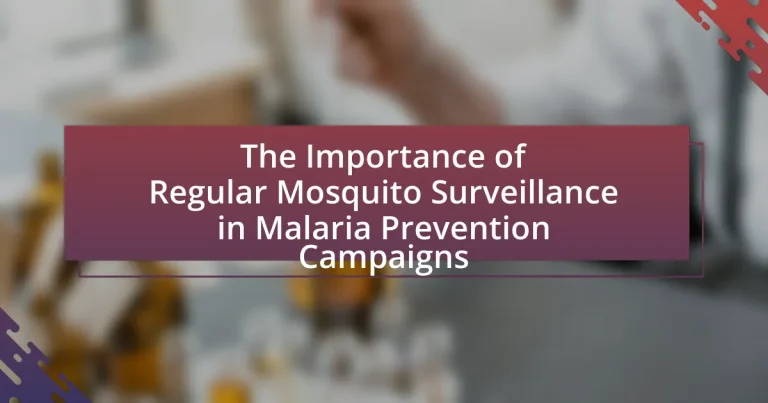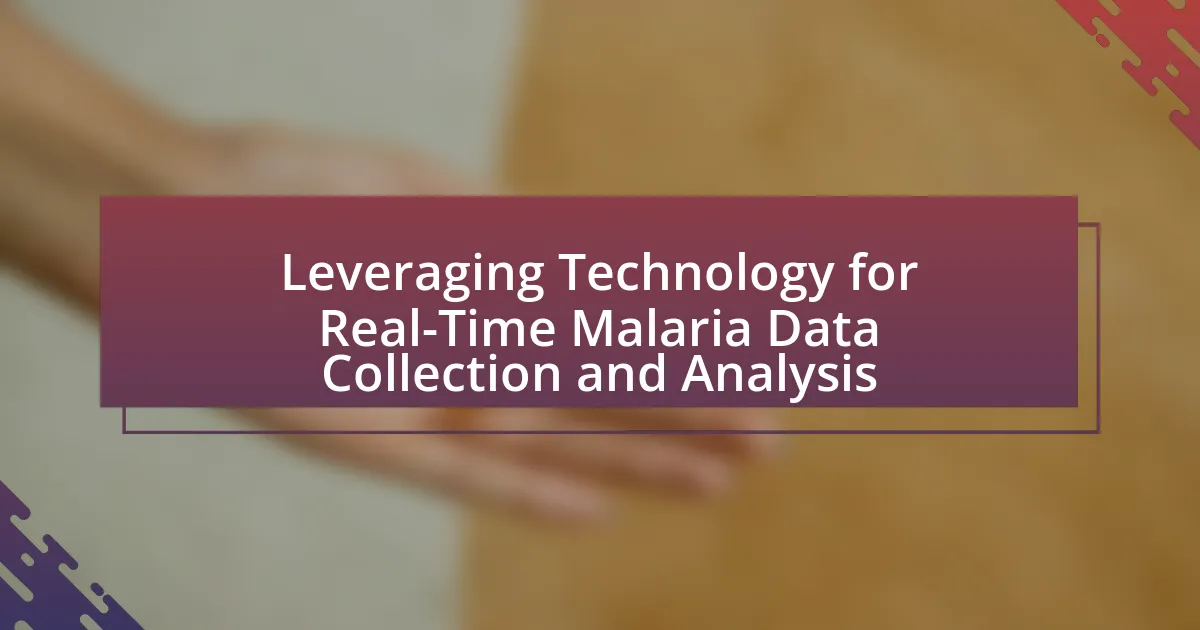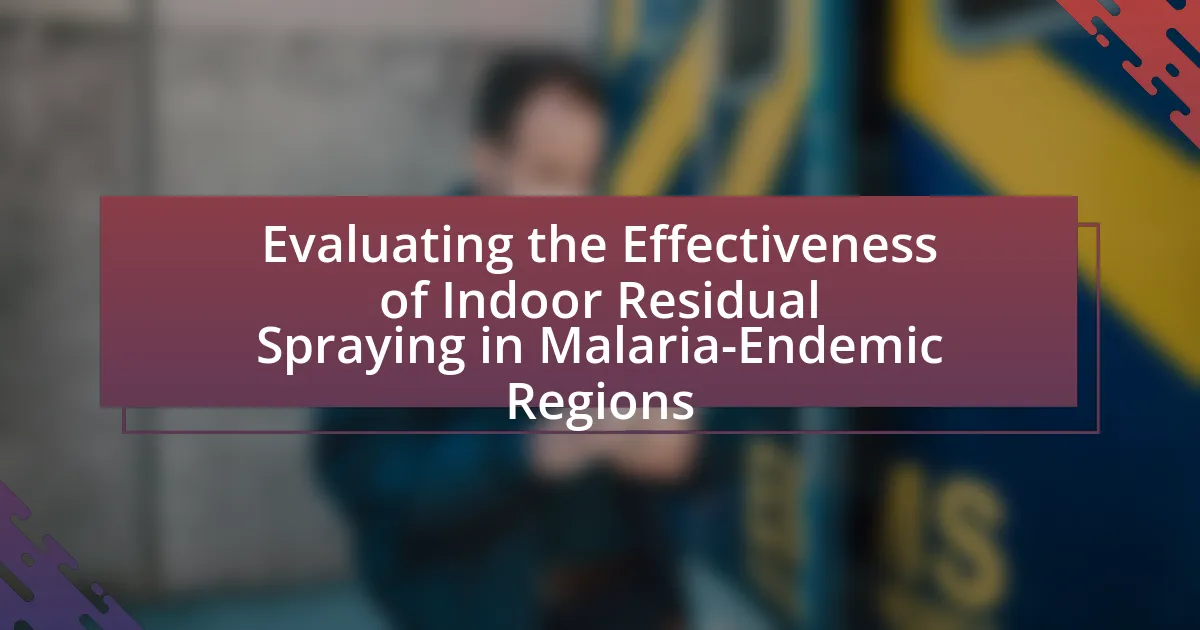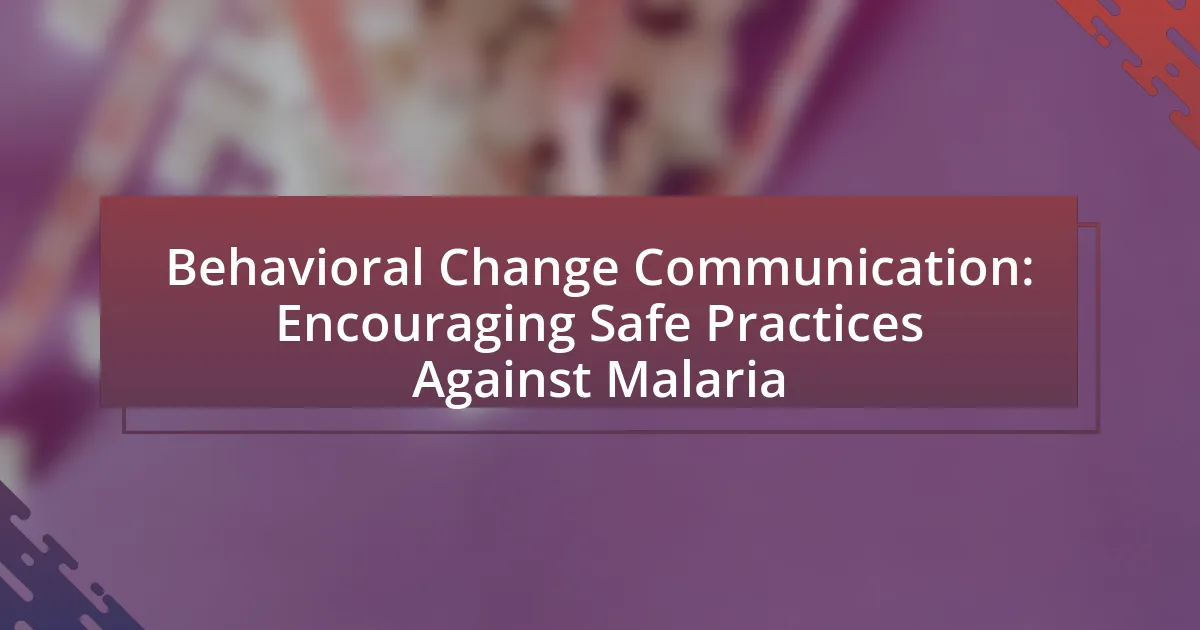Regular mosquito surveillance is a critical component of malaria prevention campaigns, as it facilitates the identification and monitoring of mosquito populations that transmit the disease. This article outlines the significance of mosquito surveillance in understanding transmission dynamics, implementing targeted interventions, and reducing malaria incidence rates. Key components of effective surveillance include monitoring species, assessing breeding habitats, and analyzing data to inform public health strategies. The article also discusses the challenges faced in implementing surveillance, the role of environmental factors, and the importance of community involvement and technological advancements in enhancing surveillance efforts.

What is the Importance of Regular Mosquito Surveillance in Malaria Prevention Campaigns?
Regular mosquito surveillance is crucial in malaria prevention campaigns as it enables the identification of mosquito populations and their behaviors, which directly influence malaria transmission dynamics. By monitoring mosquito species, density, and breeding sites, health authorities can implement targeted interventions, such as insecticide spraying or larviciding, to reduce mosquito populations effectively. Studies have shown that areas with consistent mosquito surveillance report lower malaria incidence rates, as timely data allows for rapid response to outbreaks and better resource allocation. For instance, the World Health Organization emphasizes that effective surveillance systems can lead to a 50% reduction in malaria transmission when combined with other preventive measures.
Why is mosquito surveillance critical in the fight against malaria?
Mosquito surveillance is critical in the fight against malaria because it enables the identification and monitoring of mosquito populations that transmit the disease. By tracking the distribution, density, and behavior of malaria-carrying mosquitoes, public health officials can implement targeted interventions, such as insecticide spraying and larviciding, to reduce transmission rates. For instance, the World Health Organization emphasizes that effective surveillance can lead to a 50% reduction in malaria cases in areas with high transmission. Additionally, understanding the resistance patterns of mosquito populations to insecticides helps in adapting control strategies, ensuring they remain effective over time.
What role do mosquitoes play in malaria transmission?
Mosquitoes are the primary vectors responsible for the transmission of malaria. Specifically, female Anopheles mosquitoes carry the Plasmodium parasites that cause malaria, transmitting them to humans through their bites. This transmission occurs when an infected mosquito bites a person, injecting saliva that contains the parasites into the bloodstream. According to the World Health Organization, in 2020, there were an estimated 241 million cases of malaria globally, highlighting the critical role mosquitoes play in the disease’s spread.
How does surveillance contribute to understanding mosquito populations?
Surveillance contributes to understanding mosquito populations by providing critical data on their distribution, density, and behavior. This data enables researchers and public health officials to identify hotspots for mosquito breeding and assess the risk of malaria transmission. For instance, studies have shown that targeted surveillance can reveal seasonal patterns in mosquito populations, which is essential for timing interventions effectively. Additionally, surveillance helps in monitoring the effectiveness of control measures, such as insecticide-treated nets and indoor residual spraying, by tracking changes in mosquito populations over time. This evidence-based approach is vital for adapting strategies to reduce malaria transmission effectively.
What are the key components of effective mosquito surveillance?
The key components of effective mosquito surveillance include monitoring mosquito populations, identifying species, assessing their breeding habitats, and evaluating disease transmission potential. Monitoring mosquito populations involves regular collection and analysis of mosquito samples to determine abundance and distribution patterns. Identifying species is crucial, as different species have varying capacities to transmit diseases like malaria. Assessing breeding habitats helps in understanding environmental factors that contribute to mosquito proliferation. Evaluating disease transmission potential involves testing mosquitoes for pathogens, which provides insight into the risk of disease outbreaks. These components are essential for informing targeted control measures and improving public health outcomes in malaria prevention campaigns.
What methods are used for mosquito collection and identification?
Methods used for mosquito collection and identification include the use of light traps, ovitraps, and aspirators. Light traps attract mosquitoes using light and carbon dioxide, allowing for effective capture, while ovitraps utilize water and specific attractants to collect eggs. Aspirators are handheld devices that capture adult mosquitoes directly from their environment. These methods are validated by studies showing their effectiveness in monitoring mosquito populations and species diversity, which is crucial for malaria prevention efforts. For instance, research published in the Journal of Medical Entomology demonstrates that light traps can capture a significant percentage of local mosquito species, aiding in accurate identification and surveillance.
How is data analyzed to inform malaria prevention strategies?
Data is analyzed through various methods, including statistical modeling, geographic information systems (GIS), and entomological studies, to inform malaria prevention strategies. These analyses help identify high-risk areas, understand transmission dynamics, and evaluate the effectiveness of interventions. For instance, statistical models can predict malaria outbreaks based on historical incidence data, while GIS can visualize the spatial distribution of mosquito populations and malaria cases. This data-driven approach enables public health officials to allocate resources effectively and implement targeted interventions, ultimately reducing malaria transmission rates.
What challenges are faced in implementing mosquito surveillance?
Implementing mosquito surveillance faces several challenges, including logistical issues, funding constraints, and data management difficulties. Logistical issues arise from the need for extensive fieldwork in diverse and often remote environments, making it hard to consistently monitor mosquito populations. Funding constraints limit the resources available for comprehensive surveillance programs, which can hinder the frequency and scope of data collection. Additionally, data management difficulties stem from the need to analyze large volumes of data accurately and efficiently, which requires specialized skills and technology that may not be readily available in all regions. These challenges can significantly impact the effectiveness of malaria prevention campaigns reliant on accurate mosquito surveillance.
What logistical issues can hinder effective surveillance efforts?
Logistical issues that can hinder effective surveillance efforts include inadequate transportation, insufficient funding, and lack of trained personnel. Inadequate transportation can delay the deployment of surveillance teams to critical areas, impacting timely data collection. Insufficient funding restricts the ability to acquire necessary equipment and resources, which are essential for comprehensive surveillance. Additionally, a lack of trained personnel can lead to improper data collection and analysis, undermining the effectiveness of surveillance efforts. These factors collectively impede the ability to monitor mosquito populations and assess malaria transmission risks accurately.
How do environmental factors impact mosquito populations and surveillance?
Environmental factors significantly influence mosquito populations and their surveillance. Temperature, humidity, and rainfall directly affect mosquito breeding, survival, and activity levels. For instance, warmer temperatures can accelerate the life cycle of mosquitoes, leading to increased population densities, while high humidity levels create optimal conditions for breeding in stagnant water. Research indicates that regions with consistent rainfall and warm temperatures experience higher mosquito abundance, which in turn necessitates more frequent surveillance to monitor population changes and disease transmission risks. Effective surveillance strategies must adapt to these environmental variations to ensure timely interventions in malaria prevention efforts.
How does regular mosquito surveillance enhance malaria prevention campaigns?
Regular mosquito surveillance enhances malaria prevention campaigns by providing critical data on mosquito populations and their behavior, which informs targeted interventions. This surveillance allows health authorities to identify high-risk areas and times for malaria transmission, enabling the deployment of resources and preventive measures where they are most needed. For instance, studies have shown that areas with consistent mosquito monitoring can reduce malaria incidence by up to 50% through timely insecticide spraying and community awareness programs. By understanding the dynamics of mosquito populations, including resistance patterns to insecticides, surveillance ensures that prevention strategies remain effective and adaptive to changing conditions.
What are the implications of surveillance data for public health policy?
Surveillance data significantly influences public health policy by providing evidence-based insights that guide decision-making and resource allocation. For instance, in malaria prevention campaigns, regular mosquito surveillance data helps identify high-risk areas, enabling targeted interventions such as insecticide spraying and distribution of bed nets. This targeted approach is supported by studies showing that focused interventions can reduce malaria transmission rates by up to 50% in endemic regions. Furthermore, surveillance data allows policymakers to monitor the effectiveness of existing strategies and adapt them as necessary, ensuring that public health responses remain relevant and effective in combating malaria.
How can surveillance data guide resource allocation in malaria control?
Surveillance data can guide resource allocation in malaria control by identifying high-risk areas and populations, allowing for targeted interventions. For instance, data collected from mosquito surveillance can reveal hotspots of malaria transmission, enabling health authorities to allocate resources such as insecticide-treated nets and indoor residual spraying more effectively. A study published in the journal “Malaria Journal” by Killeen et al. (2017) demonstrated that targeted interventions based on surveillance data reduced malaria incidence by up to 50% in specific regions. This evidence underscores the critical role of surveillance in optimizing resource distribution and enhancing the overall effectiveness of malaria control efforts.
What strategies can be developed based on surveillance findings?
Strategies that can be developed based on surveillance findings include targeted insecticide spraying, habitat modification, and community engagement initiatives. Targeted insecticide spraying can be implemented in areas identified as high-risk for malaria transmission, as evidenced by data showing that localized interventions significantly reduce mosquito populations and malaria incidence. Habitat modification, such as draining stagnant water sources, can be prioritized in regions where surveillance indicates breeding sites are prevalent, thereby disrupting the mosquito lifecycle. Additionally, community engagement initiatives can be developed to educate residents about preventive measures and encourage participation in surveillance efforts, which has been shown to enhance the effectiveness of malaria control programs.
What best practices should be followed for successful mosquito surveillance?
Successful mosquito surveillance requires systematic data collection, species identification, and environmental monitoring. Implementing regular trapping methods, such as CDC light traps or ovitraps, allows for accurate population assessments. Additionally, identifying mosquito species is crucial, as different species have varying roles in malaria transmission; for instance, Anopheles gambiae is a primary vector in Africa. Environmental monitoring, including assessing breeding sites and weather patterns, enhances predictive modeling for mosquito populations. These practices are supported by studies indicating that effective surveillance can reduce malaria transmission rates by up to 50% when integrated into control strategies.
How can community involvement improve surveillance efforts?
Community involvement can significantly enhance surveillance efforts by increasing local engagement and data accuracy. When community members participate in surveillance activities, they provide valuable insights into mosquito breeding sites and population dynamics, which are critical for effective malaria prevention. Research shows that community-based surveillance can lead to a 30% increase in the detection of mosquito breeding sites compared to traditional methods, as local residents are more familiar with their environment. Furthermore, involving the community fosters a sense of ownership and responsibility, leading to sustained efforts in monitoring and reporting mosquito activity, ultimately contributing to more effective malaria control strategies.
What technologies can enhance the effectiveness of mosquito surveillance?
Technologies that can enhance the effectiveness of mosquito surveillance include remote sensing, geographic information systems (GIS), and molecular techniques such as polymerase chain reaction (PCR). Remote sensing allows for the monitoring of environmental conditions conducive to mosquito breeding, while GIS helps in mapping and analyzing spatial data related to mosquito populations. Molecular techniques, like PCR, enable the precise identification of mosquito species and the detection of pathogens they may carry, which is crucial for targeted malaria prevention efforts. These technologies collectively improve data accuracy and facilitate timely interventions in malaria prevention campaigns.





